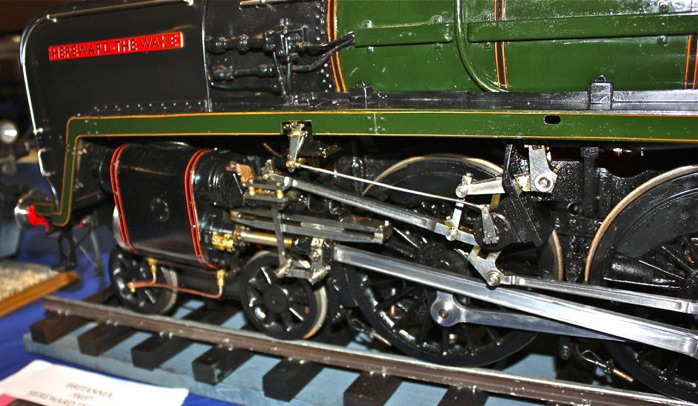Terence Woodward’s
HEREWARD THE WAKE
BR CLASS 7 IN 5” GAUGE

Terence Woodward’s
HEREWARD THE WAKE
BR CLASS 7 IN 5” GAUGE

This mighty Britannia in 5” gauge is by Terence Woodward. The drawings were purchased from Norman Spink to the design of James Perrier and he purchased a set of laser cut frames at one of the annual exhibitions. Terence does not possess a milling machine which meant a lot of filing on the horns and parts of the chassis. The cylinders were machined on his lathe and then the connecting rods were cut from the solid by chain drilling, then hacksawing, then filing off the peaks, after which hours were spent polishing all surfaces with emery cloth of various grades. The lathe was then used to mill out of all the rods using the cross slide, each of which took on average 20 hours per rod.
Being such a large locomotive Terence decided that it would be best for to move the job along and purchase a boiler from a well known professional. He had made the boiler for a previous loco, a 5” gauge 4-6-0 B2, but it was just the combustion chamber that put him off making this boiler for the Britannia.
As well as a milling machine another workshop item he would have liked to own was a bending machine. All the bends in the tender sides were made by the means of a big hammer and various lengths of angle and bars of a suitable size and diameter, to achieve the desired result.
Terence adds: “I've always followed drawings to a certain point but they always let one down when it comes to exact detail so I go from photographs to achieve the desired effect, thankfully there are an abundance of photos of Britannias and I was lucky enough to find 3 or 4 of the locomotive during the period that I required, one of which showed the engine hauling the Royals en-route to London.”
To maintain correct scale he mounted the pump onto an angled base plate and this allows the operation of the hand pump through the water pick up dome. A working water scoop is fitted.
Apart from the evocative name Hereward the Wake, the loco was easily identified by the extra high front lamp irons. The locomotive is shown with the white discs associated with the Great Eastern and the headboard, The Scandinavian.
The BR Standard Class 7, or Britannia Class, was a class of Pacific locomotives designed by Robert Riddles for mixed traffic work for British Railways. Fifty-five were constructed between 1951 and 1954 to a design meant to take the best from locos of the four pre-nationalization railways, and incorporate labour-saving measures, lowered maintenance costs and various weight-saving measures. All were were constructed at Crewe Works. The class was popular with drivers although in some areas they had difficulties keeping to schedules.
The Britannias took their names from great Britons, former Star Class locomotives, and Scottish firths. The class remained in service until the end of steam in 1968. Two survive into preservation, number 70000 Britannia, and 70013 Oliver Cromwell.


MEWS IS SPONSORED BY - CHRONOS - PAULTHECAD.CO.UK - ECCENTRIC ENGINEERING - WARCO - BRISTOL EXHIBITION - HARROGATE EXHIBITION - MERIDIENNE EXHIBITIONS - CAMDEN MINIATURE STEAM - TRANSWAVE CONVERTERS - CHERRY’S MODEL ENGINES -
Editor - David Carpenter